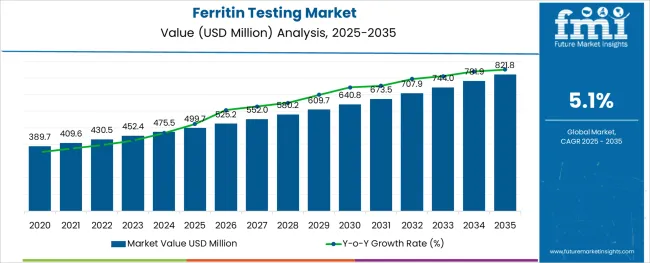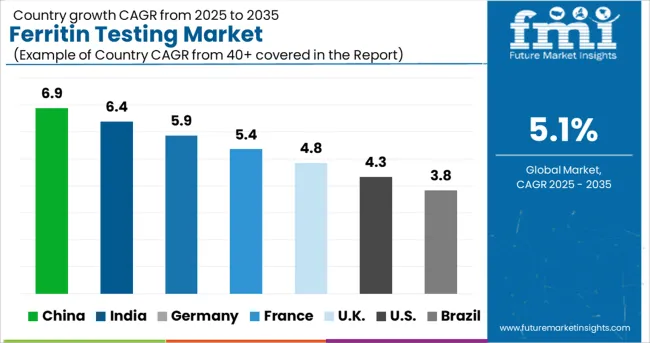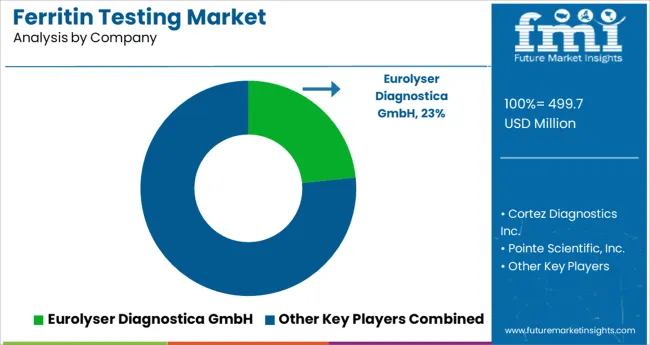The Ferritin Testing Market is estimated to be valued at USD 499.7 million in 2025 and is projected to reach USD 821.8 million by 2035, registering a compound annual growth rate (CAGR) of 5.1% over the forecast period.

The ferritin testing market is expanding steadily, driven by increasing awareness of iron deficiency and anemia worldwide. Medical professionals emphasize early diagnosis and monitoring of iron levels to manage and prevent complications associated with low ferritin, especially in vulnerable populations. Advances in diagnostic technology have improved test accuracy and turnaround times, facilitating wider clinical adoption.
The growing prevalence of anemia in both developed and developing regions has heightened demand for routine ferritin testing in healthcare settings. Hospitals and clinics are increasingly incorporating ferritin assays into standard blood panels to guide treatment decisions for patients with fatigue, chronic diseases, or nutritional deficiencies.
Public health initiatives aimed at combating anemia further support market growth. The trend toward personalized healthcare and preventive diagnostics is expected to maintain a steady rise in ferritin test utilization. Segment growth is anticipated to be driven by the Anemia indication segment and Hospitals as the primary end users of ferritin testing services.
The market is segmented by Indication and End User and region. By Indication, the market is divided into Anemia, Hemochromatosis, Lead Poisoning, and Pregnancy. In terms of End User, the market is classified into Hospitals, Specialty Clinics, and Diagnostic Laboratories.
Regionally, the market is classified into North America, Latin America, Western Europe, Eastern Europe, Balkan & Baltic Countries, Russia & Belarus, Central Asia, East Asia, South Asia & Pacific, and the Middle East & Africa.

The Anemia segment is projected to hold 48.9% of the ferritin testing market revenue in 2025, reflecting its prominence as the leading clinical indication. The growth of this segment is fueled by the high global incidence of iron deficiency anemia, which remains a major public health concern. Ferritin testing is essential for diagnosing and differentiating types of anemia and monitoring iron therapy effectiveness.
Clinicians rely on ferritin levels to assess iron stores and guide treatment in populations including women of childbearing age, children, and elderly patients. The increasing focus on early detection and management of anemia in both outpatient and inpatient settings has further driven demand.
Rising awareness about anemia’s impact on quality of life and productivity is expected to sustain growth in ferritin testing within this indication.

The Hospitals segment is anticipated to represent 57.6% of the ferritin testing market revenue in 2025, maintaining its leadership among end users. Hospitals have been the primary providers of diagnostic services due to their access to advanced laboratory infrastructure and clinical expertise.
The segment growth is supported by routine inclusion of ferritin tests in inpatient and outpatient diagnostic panels, especially for patients presenting with symptoms of anemia or chronic illness. Hospitals have also played a key role in managing iron deficiency in surgical and critical care patients, where monitoring ferritin levels is vital for optimal patient outcomes.
The expansion of hospital networks and increasing healthcare access in emerging regions have contributed to greater ferritin testing volumes. As ferritin measurement remains critical
The rising patient pool suffering from acute and iron deficiency and sickle cell anemia may drive the demand for ferritin testing services.
People suffering from disorders like hemochromatosis, lead poisoning, and pale skin may fuel the sales of ferritin testing services
Additionally, the demand for ferritin testing services is also likely to be boosted as a result of the increasing demand for rheumatoid arthritis.
Complete blood count tests may also propel the demand for ferritin testing services in the coming years.
The rising patient pool for the blood cancer and hepatitis may show lucrative opportunities for market players to enlarge their ferritin testing market share as well as facilitate higher sales of ferritin testing services.
Also, rising incidences of anemia, especially among youngsters, are forecasted to surge the overall demand for ferritin testing services, thereby spiking the sales of ferritin testing services during the forecast period.
The sales of ferritin testing services are on the rise due to steep drops in household incomes and disruptions in health, nutrition, and social protection services; child malnutrition is expected to rise.
As a result of the pandemic, the demand for ferritin testing services is taking a dip as the market in South and Central America has suffered to an adverse extent.

North America is the dominant region, and the demand for ferritin testing services is on the surge owing to a greater number of people suffering from hemoglobin deficiency-related complications.
Followed by North America, the Europe region will exhibit a fast-growing sales of ferritin testing services during the forecast period, owing to the rise in the female population suffering from the iron deficiency is more in Europe countries.
Latin America will show less demand for ferritin testing services due to the less awareness among people about blood-related disorders and anemia.
The Asia Pacific will show a good opportunity for market players to augment their ferritin testing market share on account of the rising female population suffering from a folic acid deficiency.
Countries in the APAC region like India and China are anticipated to show robust growth in the ferritin testing market.
The Middle East and Africa ferritin testing market are expected to hold a lesser ferritin testing market share due to the low adoption rate of ferritin testing kits in this region.

Some of the market participants in ferritin testing market identified across the value chain include Eurolyser Diagnostica GmbH., Cortez Diagnostics Inc., Pointe Scientific, Inc., bioMérieux SA, Humankind Ventures Ltd., Doctorcall, Aviva Systems Biology Corporation, Abnova Corporation, Biopanda Reagents Ltd, Biocompare. Monobind Inc. and others.
Mergers and acquisitions, product launches, expansions, and collaborations are all common strategies used by companies to expand their ferritin testing market share and meet rising demand by diversifying their product portfolios.
Furthermore, technological advancements are expected to drive up the ferritin testing market share.
It makes it simple to calibrate and measure the amount of iron in a patient's blood.
| Report Attribute | Details |
|---|---|
| Growth rate | CAGR of 5.1% from 2025 to 2035 |
| Base year for estimation | 2024 |
| Historical data | 2014 to 2024 |
| Forecast period | 2025 to 2035 |
| Quantitative units | Revenue in billion, volume in kilotons, and CAGR from 2025 to 2035 |
| Report coverage | Revenue forecast, volume forecast, company ranking, competitive landscape, growth factors, and trends, Pricing Analysis |
| Segments covered | Indication, End Use, region |
| Regional scope | North America; Western Europe; Eastern Europe; Middle East; Africa; ASEAN; South Asia; Rest of Asia; Australia and New Zealand |
| Country scope | USA, Canada, Mexico, Germany, UK, France, Italy, Spain, Russia, Belgium, Poland, Czech Republic, China, India, Japan, Australia, Brazil, Argentina, Colombia, Saudi Arabia, UAE, Iran, South Africa |
| Key companies profiled | Eurolyser Diagnostica GmbH.; Cortez Diagnostics Inc.; Pointe Scientific; Inc.; bioMérieux SA; Humankind Ventures Ltd.; Doctorcall; Aviva Systems Biology Corporation; Abnova Corporation; Biopanda Reagents Ltd; Biocompare. Monobind Inc. and others. |
| Customization scope | Free report customization (equivalent to up to 8 analysts working days) with purchase. Addition or alteration to country, regional & segment scope. |
| Pricing and purchase options | Avail customized purchase options to meet your exact research needs. |
The global ferritin testing market is estimated to be valued at USD 499.7 million in 2025.
It is projected to reach USD 821.8 million by 2035.
The market is expected to grow at a 5.1% CAGR between 2025 and 2035.
The key product types are anemia, hemochromatosis, lead poisoning and pregnancy.
hospitals segment is expected to dominate with a 57.6% industry share in 2025.






Full Research Suite comprises of:
Market outlook & trends analysis
Interviews & case studies
Strategic recommendations
Vendor profiles & capabilities analysis
5-year forecasts
8 regions and 60+ country-level data splits
Market segment data splits
12 months of continuous data updates
DELIVERED AS:
PDF EXCEL ONLINE
Testing, Inspection & Certification Market Growth – Trends & Forecast 2025 to 2035
5G Testing Market Size and Share Forecast Outlook 2025 to 2035
AB Testing Software Market Size and Share Forecast Outlook 2025 to 2035
5G Testing Equipment Market Analysis - Size, Growth, and Forecast 2025 to 2035
Eye Testing Equipment Market Size and Share Forecast Outlook 2025 to 2035
HSV Testing Market Size and Share Forecast Outlook 2025 to 2035
IoT Testing Equipment Market Size and Share Forecast Outlook 2025 to 2035
HPV Testing and Pap Test Market Size and Share Forecast Outlook 2025 to 2035
GMO Testing Services Market Insights – Food Safety & Regulatory Compliance 2024 to 2034
GMP Testing Services Market
LTE Testing Equipment Market Growth – Trends & Forecast 2019-2027
Drug Testing Systems Market Size and Share Forecast Outlook 2025 to 2035
Sand Testing Equipments Market Size and Share Forecast Outlook 2025 to 2035
Tire Testing Machine Market Size and Share Forecast Outlook 2025 to 2035
Self-Testing Market Analysis - Size, Share, and Forecast 2025 to 2035
Food Testing Services Market Size, Growth, and Forecast for 2025–2035
Bend Testing Machine Market Growth - Trends & Forecast 2025 to 2035
An Analysis of the Leak testing Machine Market by Detectors and Sensors Hardware Type through 2035
Soil Testing Market Growth - Trends & Forecast 2025 to 2035
Examining Food Testing Services Market Share & Industry Outlook

Thank you!
You will receive an email from our Business Development Manager. Please be sure to check your SPAM/JUNK folder too.
Chat With
MaRIA